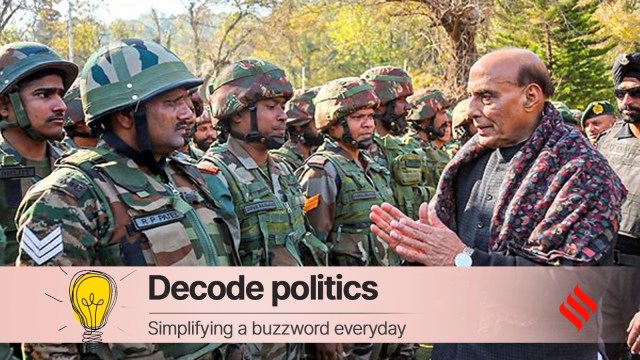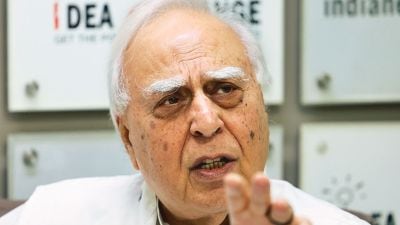Decode Politics: The Poonch ‘custodial deaths’, and the region’s restive politics
There is growing discontent among the Gujjars and Bakerwals over the Modi government's promise of ST status to Paharis, while the latter are angry over their long wait; the two can influence results in more than a dozen constituencies in Pir Panjal region.
 Defence Minister Rajnath Singh interacts with Indian Army soldiers during his visit to Jammu & Kashmir, Wednesday, Dec. 27, 2023. (PTI Photo)
Defence Minister Rajnath Singh interacts with Indian Army soldiers during his visit to Jammu & Kashmir, Wednesday, Dec. 27, 2023. (PTI Photo)The centre’s quick action in the case of the three alleged custodial deaths in J&K following an encounter, including the unprecedented visit by Defence Minister Rajnath Singh to homes of the victims’ families, also reflects another reality. The families are Gujjars, who have been solidly behind the government in a region where separatism is showing offshoots. The government is seen as hoping to quell any Gujjar anger, especially given the already simmering discontent over extension of political benefits of Scheduled Tribe status to the fellow Pahari community. Meanwhile, the Paharis, concentrated largely in the Rajouri and Poonch districts, are angry about the BJP government’s promise of reservation not fructifying.
These factors are making the BJP chary about its political position in the Pir Panjal region of Jammu division, which remains central to its J&K hopes:
How has ST reservation changed over the years?
Over the past five years, the BJP has politically invested in reaching out to the tribal community in Jammu and Kashmir so as to expand its base to areas other than those predominantly inhabited by Hindus, where it had won all the Assembly seats barring three – Udhampur, Bishnah and Nagrota – during the 2014 polls. At the time, Gujjars and Bakerwals did not have any Assembly seats reserved for them as STs.
They were declared STs along with the Shinas (Shin and Dard), Gaddis and Sippis by the Centre in 1991. Except for the Gaddis and Sippis who are Hindus, all others are Muslims. With a population of nearly 18 lakh, Gujjars and Bakerwals are a major ethnic community among STs in J&K; the combined population of the others is less than two lakh.
As part of the reservation proposal of 1991, STs were granted 10% reservation in government jobs and admissions to educational institutions, but they got a whiff of political reservation for the first time in February 2014, when the then Omar Abdullah government extended the provisions of the 73rd Constitutional Amendment to the state, providing reservation in gram panchayat seats for women, Scheduled Castes and STs.
However, real political reservation came to the STs in J&K only after the abrogation of Article 370, when Parliament passed the Jammu and Kashmir Reorganisation Act to reconstitute the state into two Union Territories and later amended it to extend reservation to STs in Assembly seats.
What was the impact of delimitation?
In May 2022, the three-member Delimitation Commission, chaired by retired Supreme Court Justice Ranjana Desai and formed to redraw J&K’s 90 Assembly constituencies, recommended the reservation of nine seats for STs. Of these, six fall in the Jammu division, including five in Rajouri and Poonch districts, and one in Reasi. The remaining three reserved seats are in Kashmir – one each in Anantnag, Ganderbal and Bandipora districts.
Though Gujjars and Bakerwals have access to only nine reserved seats after the delimitation exercise, the redrawing of Assembly constituencies is likely to make this tribal community a key player in at least 10 to 15 other constituencies, where they account for 20% to 30% of voters, says Shahid Saleem, a political analyst.
Tribal researcher Javed Rahi points out in the Nowshera constituency, there were nearly 5,000 Gujjar and Bakerwal voters in the 2014 Assembly polls. However, their number in Nowshera has now risen to nearly 25,000 following a merger with parts of the adjoining Kalakote constituency.
Similarly, the Reasi district has also seen an increase in ST voters. The district earlier had three Assembly constituencies – Reasi, Gool Arnas and Gulabgarh. After the latest delimitation exercise, which led to the creation of a new Shri Mata Vaishno Devi constituency and the deletion of Gool Arnas, there is a significant increase in number of ST voters in the Reasi and Shri Mata Vaishno Devi seats, Rahi says.
What is the status of the Paharis?
BJP leaders have made promises to extend the ST status to Paharis. This has angered Gujjar and Bakerwal leaders, who fear this will dilute the benefits coming to them from the ST status.
A senior BJP leader admits the political aspirations of the Paharis were first raised in the Central government by none other than Union Home Minister Amit Shah, who assured them ST status while promising that the reservation would be over and above the 10% already available to STs.
During the Monsoon Session of Parliament earlier this year, the Centre introduced the Constitution (Jammu and Kashmir) Scheduled Tribes Order (Amendment) Bill in the Lok Sabha to include the Pahari ethnic group, the Padari tribe and other groups in the list of STs. The Bill led to unrest among the Gujjars and Bakerwals across Jammu and Kashmir, and was not taken up for consideration even though it was listed during the Winter Session.
As the wait continues for the promise to them to be fulfilled, unrest has been building among the Paharis. In the Rajouri and Poonch districts, Paharis account for 60% of the population.
How has BJP been reaching out to STs?
In 2018, after the Bakerwals protested against BJP ministers in the then coalition government with the PDP backing the accused in the gangrape and murder of a minor Bakerwal girl in Kathua district, the BJP got its two ministers concerned to resign. The party also supported demands for a CBI inquiry.
Later that year, then Union Defence Minister Nirmala Sitharaman and then Army Chief Bipin Rawat visited the family of Aurangzeb, a soldier abducted and killed by militants, in Poonch district’s Salani village.
In 2020, when three Gujjar labourers from Rajouri were killed in an “encounter” at Amshipora in Kashmir, the J&K government not only got their bodies exhumed for identification through DNA sampling, but also Lieutenant Governor Manoj Sinha visited the victims’ families to assure them of justice. Later, J&K Police also filed a chargesheet against the accused Army officials in a Shopian court.
Most recently, Union Defence Minister Rajnath Singh met the families of three Gujjars who died after they were picked up by security forces for questioning on the militant attack near Bufliaz, in which four soldiers were killed and three others injured. He also visited the civilians in hospital with injuries allegedly sustained during torture by the Army.




- 01
- 02
- 03
- 04
- 05



























